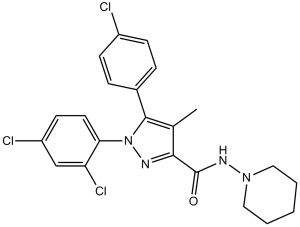This product is for research use only, not for human use. We do not sell to patients.

| Size | Price | Stock |
|---|---|---|
| 500mg | $1050 | Check With Us |
| 1g | $1650 | Check With Us |
| 5g | $4290 | Check With Us |
Cat #: V1515 CAS #: 168273-06-1 Purity ≥ 98%
Description: Rimonabant (formerly known as SR-141716; A-281; A281; SR 141716A; Acomplia; Zimulti), an anorectic antiobesity drug once used in EU but withdrawn from market due to serious psychiatric side effects, is a novel, potent and selective antagonist (inverse agonist) of cannabinoid CB1 receptor.
Publications Citing InvivoChem Products
Product Promise

- Physicochemical and Storage Information
- Protocol
- Related Biological Data
- Stock Solution Preparation
- Quality Control Documentation
| Molecular Weight (MW) | 463.79 |
|---|---|
| Molecular Formula | C22H21Cl3N4O |
| CAS No. | 168273-06-1 |
| Storage | -20℃ for 3 years in powder formr |
| -80℃ for 2 years in solvent | |
| Solubility In Vitro | DMSO: 25 mg/mL (53.9 mM)r |
| Water: <1 mg/mLr | |
| Ethanol: 2 mg/mL (4.3 mM) | |
| Solubility In Vivo | 30% PEG400+0.5% Tween80+5% Propylene glycol: 30 mg/mL |
| Synonyms | SR141716; A 281; SR-141716; A-281; A281; SR 141716A; SR 141716; SR-141716; SR 151716A; SR-141716A; SR-151716A; SR141716A; SR151716A; Rimonabant, Acomplia, Zimulti |
| Protocol | In Vivo | Rimonabant (10 mg/kg by gavage) is fed for 2 weeks to 3-month-old male obese Zucker rats as an impaired glucose tolerance model and for 10 weeks to 6-month-old male obese Zucker rats as a model of the metabolic syndrome. RANTES and MCP-1 serum levels are increased in obese vs lean Zucker rats and significantly reduced by long-term treatment with Rimonabant, which slowes weight gain in rats with the metabolic syndrome. Neutrophils and monocytes are significantly increased in young and old obese vs lean Zucker rats and lowered by Rimonabant. Platelet-bound fibrinogen is significantly enhanced in obese vs lean Zucker rats of both age, and is reduced by Rimonabant |
|---|
| Solvent volume to be added | Mass (the weight of a compound) | |||
|---|---|---|---|---|
| Mother liquor concentration | 1mg | 5mg | 10mg | 20mg |
| 1mM | 2.1561 mL | 10.7807 mL | 21.5615 mL | 43.1230 mL |
| 5mM | 0.4312 mL | 2.1561 mL | 4.3123 mL | 8.6246 mL |
| 10mM | 0.2156 mL | 1.0781 mL | 2.1561 mL | 4.3123 mL |
| 20mM | 0.1078 mL | 0.5390 mL | 1.0781 mL | 2.1561 mL |
This equation is commonly abbreviated as: C1 V1 = C2 V2
- (1) Please be sure that the solution is clear before the addition of next solvent. Dissolution methods like vortex, ultrasound or warming and heat may be used to aid dissolving.
- (2) Be sure to add the solvent(s) in order.




































